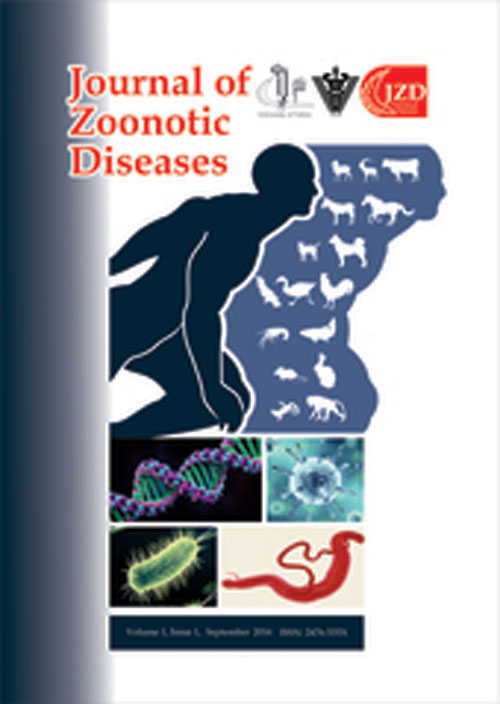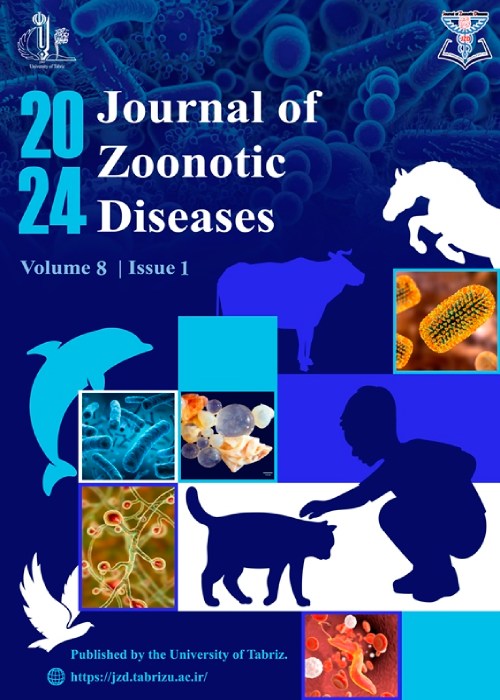فهرست مطالب

Journal of Zoonotic Diseases
Volume:5 Issue: 4, Autumn 2021
- تاریخ انتشار: 1400/11/09
- تعداد عناوین: 6
-
-
Pages 1-11
Summary Rabies is a deadly neglected zoonotic disease that affects the central nervous system of all warm-blooded animals and is widespread in many regions of the world. It is caused by rabies virus belongs to genus Lyssavirus (“lyssa” meaning “madness”), family Rhabdoviridae, and order Mononegavirales. Rabies is a devastating disease endemic in developing countries that is responsible for the death of thousands of lives every year; more than 95% of them are from Africa and Asia. Ethiopia is one of the highest human deaths due to rabies from Africa, even though the cases are under-reported. Rabies is almost fatal once clinical signs and symptoms are developed for both animals and humans. There are different modes of rabies transmission; the most common one is by being bitten by infected hosts and transferring rabies virus contained saliva through the exposure of wound or scratched skin. Domestic dogs serve as a major reservoir of the rabies virus in many developing countries and play a great role in virus transmission. Several countries that apply successful rabies elimination programs perform free post-exposure prophylaxis (PEP) for bite victims and mass dog vaccination, establish a strong national rabies surveillance system, and encourage the capacity of medical staff through sustainable training. Implementing these best experiences toward rabies elimination and dealing with great emphasis in Ethiopia is essential to avoid dog-mediated rabies deaths. In developing countries like Ethiopia, where dog-mediated rabies is endemic, execute dog vaccination policies at regional and municipal levels to break the transmission chains of rabies due to dog bites. Therefore, the government points up sustainable strong inter-sectoral collaboration and community engagement, as well as it provides safe, effective, and affordable modern anti-rabies vaccine to be used for post-exposure prophylaxis to eliminate this public health important disease.Keywords: Elimination, Ethiopia, Rabies, Vaccination, Zoonotic disease
Keywords: Elimination, Ethiopia, rabies, Vaccination, Zoonotic disease -
Pages 12-23
Summary Newcastle is one of the leading diseases among poultry. The viral agent of this disease is classified in the genus avulavirus of the paramyxovirus family. Since the disease has a harmful impact on poultry production, it is one of the main economic problems that can be studied by virology scientists. Even though, Newcastle disease virus (NDV) has been extensively studied in recent years, our information on immune responses to this virus remains incomplete. NDV is a zoonotic agent that can cause infection in humans. The common transmission route of NDV is through contact of contaminated fingers with the eyes after careless handling infectious poultry samples. Like all infectious diseases, vaccination can enhance NDV control. Today, there are three types of NDV vaccines, including live inactive and vector-based vaccines. Since NDV is an economical concern to governments, its problem must be solved. To find effective solutions to this problem, our knowledge about immune responses to ND has to be completed. In this review, we discussed some aspects of these responses.
Keywords: NDV, Innate immunity, Cell mediated immunity, Humoral immune system, Zoonotic disease, Vaccination -
Pages 24-30As an insidious disease, Visceral Leishmaniasis (VL), is considered a serious public health issue that affects Brazil in almost its totality. This study evaluated the endemicity of VL in municipalities in the State of Minas Gerais in a historical series from the perspective of Biomimetics Science. A retrospective analysis was carried out between 2010 and 2019 of VL cases registered in the National System of Reported Diseases (Sistema de Informação de Agravos de Notificação - SINAN). In the studied period, 4.834 cases of the disease were reported in Minas Gerais. The cities of Belo Horizonte and Montes Claros were identified as the locations with the most expressive numbers of cases. The absence or reduced endemicity of the disease in the west and extreme south of the state of Minas Gerais was detected in the period analyzed. It is suggested that, over the time, there are areas that control the transmission of the disease by itself. Considering the principle of biomimetics, it would be important to identify that in these areas without the disease, which elements can be learned from nature to direct LV control actions.Keywords: Visceral Leishmaniasis, Biomimetics, Endemicity, Minas Gerais, Brazil
-
Pages 31-41Mycobacterium avium subsp. Paratuberculosis is the causative agent for Johne’s disease, which is a chronic and virulent disease, usually leading to incurable chronic enteritis. The bacterium afflicts domestic and wild ruminants. Milk and feces are important sources for the bacterial presence as well as pathogenic factors for the dissemination of infection. The human beings can be affected by raw and pasteurized milk, meat, and the environment. The aim of this study was to identify and determine the mycobacterium avium paratuberculosis prevalence in milk, feces, ileocecal area, and meat of slaughtered cattle in the Tabriz slaughterhouse. For the present study, 30 dairy cows two years of age or older were randomly selected in the Tabriz slaughterhouse. Milk and fecal sampling, and ileocecal and meat sampling, were conducted in several stages before and after slaughtering, respectively. The DNA was extracted from 120 samples at first, and then PCR was performed using IS900 specific primers. The obtained PCR products were electrophoresed on the agarose gel. Considering the results, the rate of mycobacterium infection was 26.7% in milk, 33.3% in feces, and 6.7% in ileocecum, and the infection rate was negative in meat. With regard to the procured results of the present study, the identification of mycobacterium avium subsp. paratuberculosis using the PCR method is a valuable test in herds. Since the present study showed a high infection rate in the district and considering the probable association between the bacterium and Crohn’s disease in humans, the need for further attention deems necessary.Keywords: Mycobacterium avium subsp. paratuberculosis, Johne's disease, PCR, Tabriz
-
Pages 42-49The fungi are a part of the normal flora of the skin of animals, including horses. Although some of the fungal species are pathogen, most of them are opportunistic and can cause opportunistic fungal infections. The present study aimed to identify pathogenic and saprophytic fungi isolated from horse cutaneous lesions. In this study, 183 horses of eight horse-riding clubs were dermatologically examined in Ardabil city. In each case, the clinical sample was obtained from the cutaneous lesions. The specimens were inoculated on Sabouraud dextrose agar plates with chloramphenicol and cycloheximide, as well as direct microscopic examination of fungal elements. 25 cases of the 183 examined horses had cutaneous lesions (13.6%). Among the cutaneous lesions, alopecia (in 13 cases) and crust (in one case) had the highest (52%) and lowest (4%) frequency rates, respectively. 92% of inoculated samples (23/25) were positive on fungal culture media, of which only four samples (17.3%) isolated as pathogenic fungi (Microsporum canis and Malassezia pachydermatis). In other cases, only saprophytic fungi were isolated. The highest and lowest isolated saprophytic fungal species were Aspergillus niger (47.8%) and Rhizopus (4.3%) and Stemphylium (4.3%), respectively. Also, Rhizopus and Aspergillus niger were the highest isolated fungal species in horses without any dermal lesions (25%). The study showed pathogenic fungi including dermatophytes were isolated from a relatively low percentage of cutaneous lesions in horses. Saprophytic fungi are likely to play a role in horses cutaneous lesions and sometimes may cause these infections or worse them.Keywords: Fungal disease, Dermatophyte, Horse
-
Pages 50-54
Aspergillosis is an important infectious fungal disease; caused the genus of Aspergillus that affects humans, mammals, and mainly wild or domestic birds. The following case report describes a clinical case of aspergillosis in a quail flock. A thousand flocks breeding quail originated from a hatchery located in Iran, in late spring, from the age of one week, have been encountered with breathing difficulties. The daily mortality of infected chicks was 20-30 chicks (total of 50%). The most prevalent clinical signs were respiratory symptoms such as dyspnea, open beak breathing, and increased respiration. Other clinical signs included depression, anorexia, decreasing weight, and in some stance cyanosis. The large number of white caseous nodules with an average diameter of 1-3 µm, often in the lungs and also in the liver, mesenteric intestine vessels, muscles of the chest, and heart were observed. Lungs, beak cavity, pharynx, and air sacs frequently consisted of the caseous nodules. The large numbers of germinating conidia centrally and hyphae extending peripherally through the layer of macrophages were found on the granulomas stained by Gomori’s methenamine silver. In some other tissue samples, conidiophores of A. fumigatus, and conidial heads were formed. Mycological examination of the postmortem samples demonstrated A. fumigatus. Poor husbandry, ventilation, sanitation were common conditions that predispose quails to aspergillosis in the present report.
Keywords: fungal infection, Aspergillosis, lung, quail


